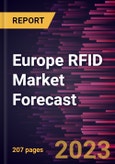Rising Deployment of RFID Technology Fuels Europe RFID Market
RFID technologies are used for various applications in many industries such as food, airline, and blockchain, due to technological advancements and rising awareness regarding their benefits. For instance, RFID tags can be attached to food products to track their movement throughout the supply chain. It helps improve inventory management, prevent food spoilage, and ensure food safety.Additionally, in April 2021, Stora Enso launched its"world-first" recyclable RFID tag for microwave-safe use. The Eco Meal RFID tag is designed for item-level ready to eat meal tagging and tracking. Such application and product development propel RFID technology adoption in food industries.
In the airline industry, RFID tags can provide accurate information about the location and status of emergency equipment, aircraft systems, and passengers. It can help to improve decision-making during an emergency. Additionally, RFID can help airport authorities improve baggage handling by automating many manual processes, such as checking in bags, loading bags onto airplanes, and unloading bags from airplanes. It can help reduce the wait times for passengers in baggage handling. Such benefits of the technology propel the adoption of RFID technologies in airline industries.
Europe RFID Market Overview
The Europe RFID market in Europe is sub segmented into France, Germany, Italy, Sweden, Belgium, Russia, the UK, and the Rest of Europe. RFID solutions have wide applications in diversified industrial verticals, such as manufacturing, logistics, waste management, and automotive. The retail industry is well established in Europe, with the presence of the world's major retail brands, especially in the clothing sector. RFID technology finds a huge demand in the European retail market. Shoppers are open to scanning Universal Product Codes in self-checkout systems, with RFID tags making self-checkout faster and more precise. Decathlon, a French sports-equipment company with over 1,600 outlets in over 50 countries, tags more than 85% of its merchandise, doubling labor productivity and reducing stockouts to increase revenue by 2.5%. European businesses are also testing several RFID-based checkout technologies. For example, in Europe, the scan-and-go technology allows customers to scan and pay for items using their smartphones, instantly silencing RFID tags and skipping checkout lines. In the age of physical distances, helping customers avoid close contact with checkout personnel provides a competitive advantage.Further, Europe is known for its high living standards and higher per capita income levels, which has led to the development of smart cities, smart homes, and various other advanced infrastructure projects. RFID products, such as smart locks, sensor locks, and RFID face readers are becoming increasingly popular due to such developments. Such growing smart infrastructural projects drive the RFID technology demand in the region.
Europe RFID Market Revenue and Forecast to 2030 (US$ Million)
Europe RFID Market Segmentation
The Europe RFID market is segmented into type, frequency band, end user, product, offering, application, and country.Based on type, the Europe RFID market is segmented into active and passive. The passive segment held the larger share of the Europe RFID market in 2023.
Based on frequency band, the Europe RFID market is segmented into low frequency, high frequency, and ultrahigh frequency. The high frequency segment held the largest share of the Europe RFID market in 2023.
Based on end user, the Europe RFID market is segmented into public sector, healthcare, education, sports & recreation, hospitality, residential, BFSI, manufacturing, telecommunications, and others. The hospitality segment held the largest share of the Europe RFID market in 2023.
Based on product, the Europe RFID market is segmented into cards, key fob, smartphones, band, and others. The cards segment held the largest share of the Europe RFID market in 2023.
Based on offering, the Europe RFID market is segmented into tags, readers, and software & services. The tags segment held the largest share of the Europe RFID market in 2023.
Based on application, the Europe RFID market is segmented into parcel & mailboxes, lockers, ticketing, and others. The others segment held the largest share of the Europe RFID market in 2023.
Based on country, the Europe RFID market is segmented into France, Germany, the UK, Italy, Russia Sweden, Belgium, Netherlands, Switzerland, and the Rest of Europe. Germany dominated the share of the Europe RFID market in 2023.
APK Identification; Assa Abloy AB; dormakaba Holding AG; Honeywell International Inc; Impinj Inc; OMRON Corp; Siemens AG; and Zebra Technologies Corp are some of the leading companies operating in the Europe RFID market.
Reasons to Buy
- Save and reduce time carrying out entry-level research by identifying the growth, size, leading players, and segments in the Europe RFID market.
- Highlights key business priorities in order to assist companies to realign their business strategies.
- The key findings and recommendations highlight crucial progressive industry trends in the Europe RFID market, thereby allowing players across the value chain to develop effective long-term strategies.
- Develop/modify business expansion plans by using substantial growth offering developed and emerging markets.
- Scrutinize in-depth Europe market trends and outlook coupled with the factors driving the market, as well as those hindering it.
- Enhance the decision-making process by understanding the strategies that underpin security interest with respect to client products, segmentation, pricing and distribution.
Table of Contents
Companies Mentioned
- APK Identification
- Assa Abloy AB
- dormakaba Holding AG
- Honeywell International Inc
- Impinj Inc
- OMRON Corp
- Siemens AG
- Zebra Technologies Corp
Table Information
| Report Attribute | Details |
|---|---|
| No. of Pages | 207 |
| Published | September 2023 |
| Forecast Period | 2023 - 2030 |
| Estimated Market Value in 2023 | 5371.36 Million |
| Forecasted Market Value by 2030 | 11456.34 Million |
| Compound Annual Growth Rate | 11.4% |
| Regions Covered | Europe |
| No. of Companies Mentioned | 8 |








